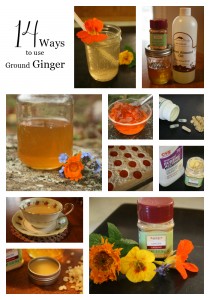
I know when I was first learning about herbs, I would excitedly read a new recipe or tutorial only to find out it needed some exotic-sounding special ingredient that required an internet order to obtain. I remember that feeling of frustration and thought that today, I’d share with you fourteen ways to use ground ginger, easily obtained from the spice section of your local supermarket.
Optimally, you’d want an organic brand, but these recipes should work with whatever type is available to you. For this post, I went to my local WalMart and spent $3.98 for a 1 ounce bottle of ground ginger. Normally, I use ginger purchased in bulk from Mountain Rose Herbs, where 4 ounces of fresh, high quality, organic ground ginger root only costs $3.50. The savings really add up when you buy all of your herbs & spices at a price like that!
Before we get started, a quick rundown on some of the potential benefits of ginger:
- anti-inflammatory, useful for rheumatic & arthritic conditions that feel better when heat is applied
- helps warm & energize the body when you are chilled and/or sluggish feeling
- helps with colds & flu when chills & congestion are among the symptoms
- and it really stars in alleviating upset stomach, nausea & vomiting
It’s important that if you have high or low blood pressure, have any bleeding disorders or are on blood thinners or other such medications, that you consult your health care professional before using a lot of ginger in therapeutic doses. Eating a piece of ginger candy here and there will not hurt you, but taking large concentrated doses of ginger very well may exacerbate your symptoms or alter how your medication works. Only your doctor or naturopath, with the knowledge of your medical history, will know this for sure, so always seek out their wise council first.
Okay, now that you’ve got the basic info and disclaimers, let’s get started!
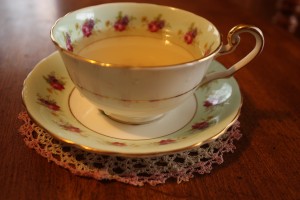
1. Tea
Ginger tea is easy to make. Measure 1/4 teaspoon of ground ginger into a heat proof mug or glass and pour 1 cup of boiling water over it. Cover with a saucer and let sit until cool enough to drink before straining. Sweeten with honey or sugar as desired. The dose for children: 1/4 cup every two to three hours and aim for no more than 1 to 2 cups total per day.
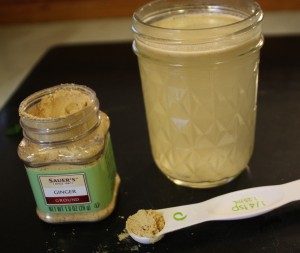
2. Compress
A compress, or fomentation, is helpful for painful joints, muscle sprains or stomach aches. Make a tea (see #1 for directions), soak a piece of flannel or washcloth for about 5 minutes, wring out and immediately place on painful area. Cover with a towel, then a heating pad or hot water bottle, then another towel. Leave on for 20 minutes. Repeat if needed.
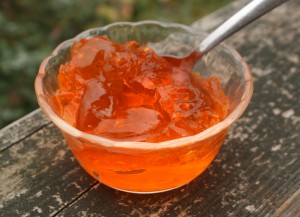
3. Herbal Jello
I recently covered this in the posts Herbal Jello and Healthier Herbal Jello. If you use regular jello, lemon or orange are fabulous flavors to blend with ginger!
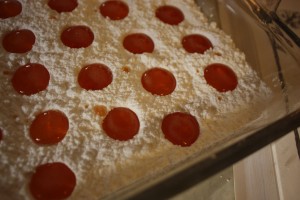
4. Candy
Ginger candy is a yummy way to help alleviate the queasiness that sometimes accompanies pregnancy or traveling. To make herbal candy you will need: 1 cup of prepared ginger tea (you may want to increase the amount of ginger if a stronger flavor is desired) and 1 1/2 cups of sugar. Stir together well in a deep, heavy saucepan. Boil over medium to medium-high heat, without further stirring, until mixture reaches 300 to 310 degrees F, periodically wiping the sides down with a wet pastry brush to prevent crystallization.
I like to use homemade corn-free powdered sugar as molds. You can see more details about that method and this recipe at my Rose-Petal Peppermint Drops post. It is essentially the same recipe, only the “rose petal tea” is changed to ginger tea. You can use this method with virtually any herb or edible flower you’d like! (Elderberry is another favorite!)
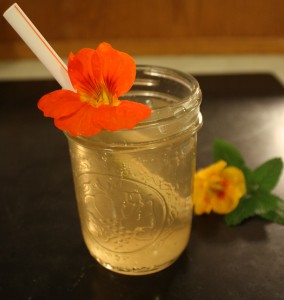
5. Ginger Ale Fizz
This is a fun drink, especially for kids. The recipe comes from A Kid’s Herb Book by Lesley Tierra. This is a wonderful book that both my daughter and I have poured over many times. It’s a highly recommended resource for your home library! Make a tea, as directed in #1, only use twice as much ginger. So the ratio will be 1/2 teaspoon ginger to 1 cup boiling water. Simmer the mixture for 5 minutes to reduce it a bit, then let sit for ten minutes before straining. Stir in 2 teaspoons of sugar/honey (adjust to taste) then gently add up to 1/2 cup carbonated water. Drink right away to preserve the fizz factor. You can also omit the sugar/honey and replace the carbonated water with 1/2 cup ginger aleor other light tasting natural soda. (This is a useful alternative for those accustomed to a “soft drink” type taste, but still gets the helpful herb in them.)
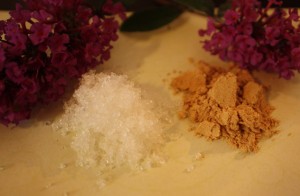
6. Foot Bath
A ginger foot bath is invigorating! It helps warm up and stimulate the entire body by increasing circulation to the feet and legs. Persons with diabetic retinopathy may find this helpful, however, it would be wise to double check with your health care provider first.
Bring 2 quarts of water to a boil then add up to 2 tablespoons of powdered ginger and a pinch or two of sea salt (optional.) Let this cool quite a bit before pouring into a basin or tub that will fit your feet comfortably. For your first ginger footbath, start with a smaller amount of ginger then work your way up. Soak feet for ten to twenty minutes at a time.
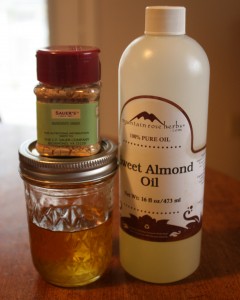
7. Oil
Ginger root oil can be rubbed onto achy joints to help relieve some of the pains associated with arthritic conditions. Another use is placing 2 to 3 drops on a piece of cotton or cotton ball and placing in an aching ear for several hours. I like to use it in salves and balms that I make intended for sore muscles. See my Aches & Pains Balm recipe for an example of this.
To make the oil, place several pinches or spoonfuls (you don’t really have to be exacting on this) of ground ginger in a small jar. Pour olive oil or sweet almond oil over the spice. Shake well and allow to infuse for several weeks in a cool, dark place. Shake every couple days or as often as you remember. After about four to six weeks, strain out the oil and store in a sterilized jar with a tight cap. This will keep about a year if stored properly.
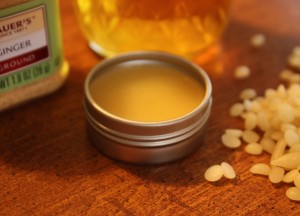
8. Salve
While you can use the ginger root oil directly as is, sometimes it’s more convenient and less messy to apply in salve form. To make a salve from the oil you made in #7 above: Measure out 1 tablespoon ginger oil and 1/2 teaspoon of beeswax. Combine together in a heat proof small jar such as a jelly jar. Set this into a pan with a few inches of water. Slowly heat the water (not to boiling!) until the beeswax melts. Pour into a small 1/2 ounce tin. Allow to set up then cap and store in a cool, dark cabinet. Apply as needed.
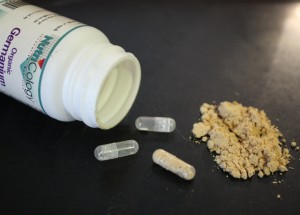
9. Capsules
Capsules of ginger are great to take right before a trip, if you are prone to motion sickness. They’re also helpful for when you’re feeling a bit icky, run down, or your stomach feels yucky. I make my own capsules two ways. The first is by using encapsulation tools I bought from Mountain Rose Herbs.
My other, really cheap way that I often employ is to reuse tiny supplement capsules that we only take a sprinkle of at a time. For instance, germanium is excellent to take when you’re sick. But, I don’t like to take large amounts of any one vitamin or mineral because that’s a good way to upset the balance of its cofactors; I’m a micro-doser. So, if someone is under the weather, I might mix a spoonful of honey with a tincture or a bit of herb like olive leaf and I will also add a sprinkle of germanium. I save all of the capsules once they’re empty and toss them back in the bottle. I repry them open and use a tiny measuring spoon to refill with powdered ginger. Then, I have an easy-to-swallow sized pill perfect for kids and those with a sensitive gag reflex.
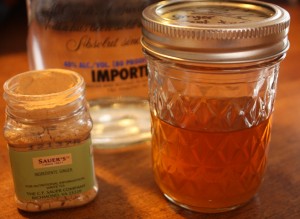
10. Tincture
I can’t make this list without mentioning tinctures! To make one, put a generous pinch or two of ground ginger in a small jar then cover with 80 proof or higher vodka or brandy. Cap and shake well then store in a cool, dark place like a cupboard. After six weeks or so, strain out the herbs and rebottle the tincture in a sterilized jar. Label clearly with the date and ingredients. These will keep for years!
A general dosage for adults is 3 dropperfuls, three times a day, half as much or less for a child. I usually dispense tinctures to my children about 3 drops at a time. I like to dose ginger tincture in a glass of ginger ale. But, you can also mix some with a spoonful of honey. Some brave souls even take a dropperful directly in the mouth, followed by a swig of water. (I am not so much a brave soul!)
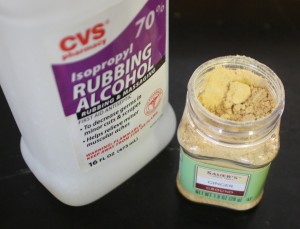
11. Liniment
When I was a kid, my parents had this bright green, minty smelling alcohol I would rub on my legs when I had growing pains. Now I know that this is called a liniment and is easily duplicated at home. Depending on which herb you choose, your liniment will be warming or cooling. A ginger liniment is warming and can increase blood circulation and help when you’re feeling stiff and achy – especially if the discomfort is a result of cold weather.
To make a liniment: place several pinches of ground ginger in a jar. Cover completely with rubbing alcohol (you can also use witch hazel extract or vinegar) then cap. Let this sit in a cupboard for a couple of weeks, shaking whenever you remember. After this amount of time, strain out and discard the ginger. Rebottle the liniment in a (preferably dark) bottle. Make sure to clearly label that this is for external use only and keep out of reach of children. If you have any concern at all about children getting into this, then use vinegar as your menstruum instead of rubbing alcohol. Rub this on strained muscles and areas of arthritic pain.
12. Medicinal Vinegar &/or Oxymel
I covered this in the post How to Make Medicinal Vinegars & Oxymels. Ginger Oxymel is helpful for chest congestion and queasy tummies.
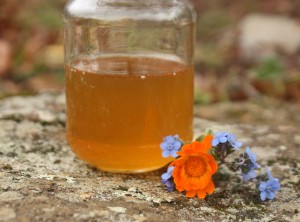
13. Ginger Syrup
Before I found out my issues with gluten, I almost constantly felt sick. It was reminiscent of the morning-and-all-day queasiness I felt when pregnant. For a few years, Maalox was my lifesaver and I went through bottle after bottle of it. (Eek! I know!) Then, I became more health-conscious and switched to some tiny, expensive bottles of ginger syrup from the health food store. Eventually, I figured out that food can be the root of many illnesses, dropped the gluten and queasiness became a thing of the past! I now also know that I could have saved a ton of money by making my own ginger syrup.
While there are several methods of making ginger syrup, I’ll share an easy honey-based one with you now.
First, make a very strong tea (see directions on #1 of this list.) Use twice as much ginger or half as much water when making your tea – you may want to experiment to find what strength works best for you, but that’s a good starting point. Measure out a small amount of tea and put into a saucepan. Next, measure out two to three times as much honey, as tea. I can’t recommend raw, local honey highly enough, but use what you can get. Stir this together and heat gently over low heat. You don’t want your syrup to get over 110 degrees F in order to preserve the benefits of the raw honey.
Once the ingredients are fully incorporated, remove from heat and pour into a sterilized jar. Store for up to six months in the refrigerator. Dosing: 1 to 2 teaspoons for children, 1 tablespoon for adults up to five times per day, as needed.
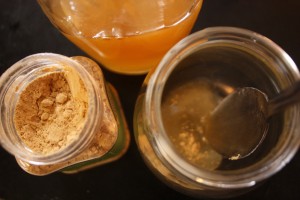
14. Honey Mixture
Finally, the last way you can use ground ginger is the quickest, easiest and my most favorite way. Just put a spoonful of honey into a tea cup or small bowl, put in a tiny pinch of ginger, stir together then eat! Can’t beat the simplicity of that!
I hope these fourteen ways to use a bottle of ground ginger from the grocery store helps you realize that you don’t have to wait until you can buy expensive, exotic sounding ingredients to start experimenting with herbs. Use what you have handy, right now!
Love this!!
ReplyDelete